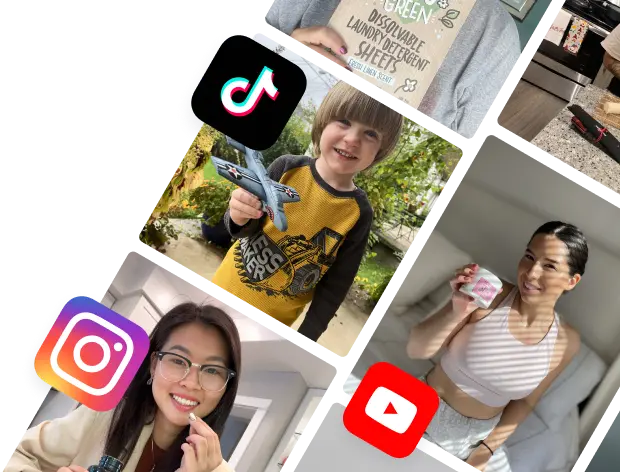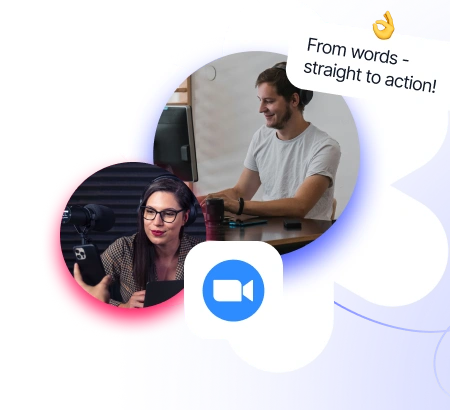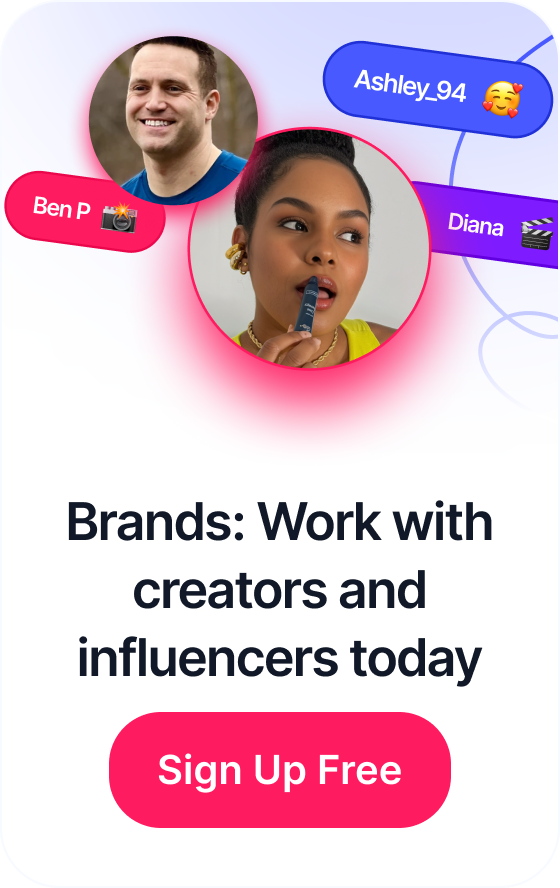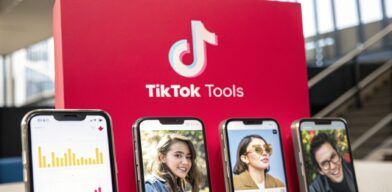 Best Brand Ambassador Programs: Top Picks to Grow Reach
Best Brand Ambassador Programs: Top Picks to Grow Reach
Table of Contents
Why User Generated Videos Are Changing Everything
Let's get real for a moment. Your audience is constantly bombarded with polished, high-budget corporate videos. They’ve developed a sixth sense for spotting an ad and scrolling right past it. This is where the marketing playbook gets a major rewrite, and why user-generated videos are much more than a passing fad—they're essential. The bottom line is, people trust other people, not just brand logos.
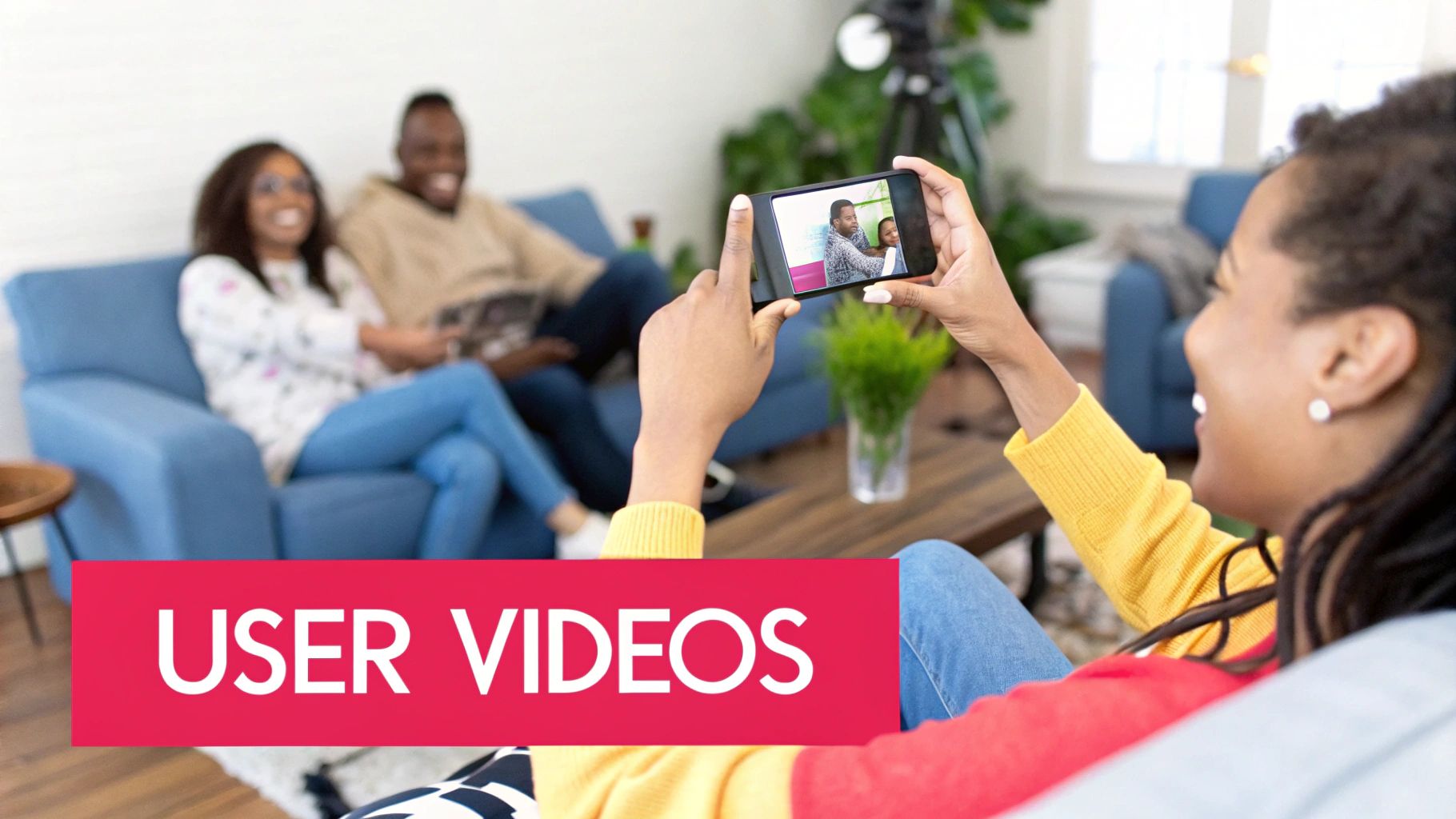
The Power of Authentic Connection
Think about the last time a friend recommended a new gadget or a place to eat. You probably took their suggestion more seriously than a random ad you saw online. That's the same psychological principle that user-generated videos tap into. They function as large-scale peer recommendations. When a potential buyer sees a real person—not a hired actor—unboxing your product or showing how it fits into their daily routine, it instantly creates a sense of trust.
This isn't just a hunch; the data proves how much consumers prefer this kind of raw, unscripted content. On platforms like TikTok, user-generated content is 22% more effective than videos created by brands themselves. The difference is even more dramatic when compared to traditional ads. UGVs on TikTok can outperform branded Facebook ads by 32% and are an incredible 46 times more effective than standard advertising on the platform. Similarly, on YouTube, authentic clips from users pull in nearly 10 times the views of official brand content. To see more on how genuine content is reshaping social platforms, you can explore detailed UGC statistics.
From Passive Viewers to Active Participants
What really makes these videos so powerful is how they change the entire marketing dynamic. Instead of a one-way message from your brand to the customer, you start a genuine conversation. You’re no longer just selling a product; you're inviting customers to share their experiences and become a part of your brand's story. This feeling of involvement builds a strong community and lasting loyalty. When people feel seen and appreciated for their content, they transform from single-purchase customers into passionate brand advocates.
This move toward audience involvement is a key part of where marketing is headed. To get a better sense of the bigger picture and the significant role of UGVs, it's worth following the evolving video marketing trends. By embracing user-generated videos, you stop broadcasting into an empty room and start building a community that promotes your brand for you, creating a powerful, self-fuelling engine for growth.
Building Your User Generated Video Campaign Foundation
It’s tempting to jump right in and just start asking for videos, but that’s a common mistake that almost always ends in a lackluster response. A powerful user generated videos campaign isn't something you can just wish into existence; it's built on a solid strategic plan. Before you even brainstorm a hashtag, you need a crystal-clear picture of what success means for your brand.
This involves setting specific, measurable goals that tie directly into your larger business objectives. Are you trying to bump up the conversion rate on a specific product page? Maybe you want to build brand awareness with a new demographic or gather authentic testimonials for your next ad spend. Each of these goals demands a unique approach.
Knowing Your Audience and Where They Live Online
Once you've nailed down your objectives, it’s time to get specific about who you're trying to reach. "Our customers" is too broad. You need to dig deeper and identify your most engaged followers—the people who consistently like, comment, share, and buy from you. Where do they hang out online? A campaign targeting Gen Z will likely perform best on TikTok, while one aimed at millennial homeowners might see more action on Instagram Reels or a private Facebook Group.
Think about a brand like GoPro. They don't just ask for generic adventure clips. They tap into a vibrant, pre-existing community of adrenaline junkies who are already creating and sharing exactly the kind of high-octane content they want. That’s the level of audience understanding you should aim for.
To get a better idea of where your specific audience is most active and what kind of content resonates, it's helpful to compare the major platforms.
Platform Comparison for User Generated Video Campaigns
Comparison of major social platforms showing their strengths for UGV campaigns, audience demographics, and content formats
| Platform | Best For | Audience Age | Content Format | Engagement Rate |
|---|---|---|---|---|
| TikTok | Viral trends, short-form entertainment, authenticity | 18-24 | Short videos (15-60 seconds) | High |
| High-quality visuals, lifestyle content, influencer collaborations | 25-34 | Reels, Stories, Carousels | Medium-High | |
| Community building, detailed storytelling, diverse demographics | 25-44+ | Videos, Live streams, Group posts | Medium | |
| YouTube | In-depth reviews, tutorials, long-form storytelling | 18-49+ | Long-form video, Shorts | Varies (High for niche communities) |
This table shows that choosing the right platform is critical. A campaign that would thrive on TikTok's fast-paced, trend-driven environment might not get the same traction on Facebook, which is better suited for community-focused, longer-form video. Matching your campaign to the platform's strengths and user base is a key first step.
Setting the Stage for Success
With your goals and audience dialed in, you can begin to map out the practical details. A well-considered timeline and budget are absolutely essential. Your schedule should cover every phase: the initial launch and promotion, the window for users to create and submit their videos, the time needed for moderation and review, and finally, the period where you celebrate and showcase the best content. For a more detailed look at building a solid plan, this guide on a user-generated content strategy that truly converts offers some great insights.
This upfront planning is what separates campaigns that generate a wave of authentic, compelling content from those that never quite get off the ground.
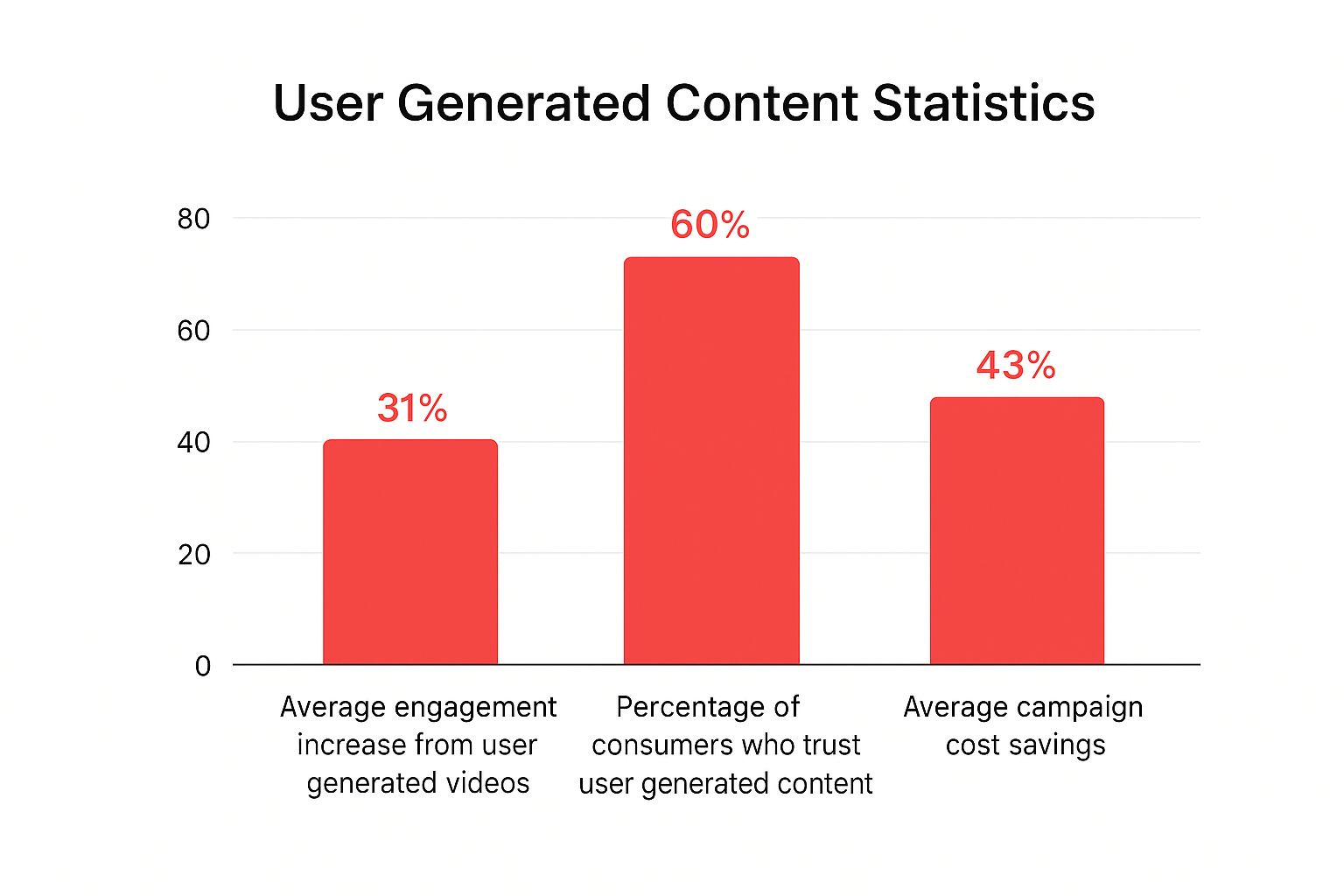
As you can see, the payoff for this strategic work is huge. The benefits aren't just about getting more likes or shares; they translate into real gains in consumer trust and significant cost savings. This powerful combination makes a thoughtful approach to your campaign's foundation a non-negotiable step toward achieving real results.
Campaign Concepts That Make People Want To Participate
The biggest difference between a campaign that flops and one that generates thousands of authentic user generated videos isn't the size of the prize—it's the core concept. A brilliant idea connects with your audience's existing passions and daily routines, making participation feel less like a marketing chore and more like a fun community activity. The goal is to make creating content for your brand feel like a natural extension of what they already love to do.

Finding Your Campaign's Creative Spark
So, how do you brainstorm a concept that truly connects? Start by digging into the "why" behind your product. Don't just list its features; think about the feeling or outcome it creates. A skincare brand isn't just selling moisturizer; it's selling confidence and self-care rituals. A coffee company isn't just selling beans; it's selling the perfect start to a productive morning.
Remember Coca-Cola's "Share a Coke" campaign? It wasn't really about the soda itself, but about creating moments of connection between friends and family. This simple, human-centered idea was easy for anyone to get involved in, and it turned into a global sensation. Your concept should give people a reason to share a personal story where your product just happens to play a supporting role.
Consider these angles to get your own ideas flowing:
- Transformations: This classic "before and after" format is a winner for fitness, home improvement, or beauty products.
- Life Hacks: Ask users to show off a clever or unexpected way they use your product to make their lives easier or more fun.
- A Day in the Life: Invite people to show how your product fits seamlessly into their daily routine. It's a fantastic way to get authentic, real-world context.
- The Ultimate Challenge: Create a fun, skill-based challenge related to your product. For example, a camera brand could launch a contest for the "best one-minute travel film."
Balancing Freedom with Clear Guidelines
Once you've landed on a great concept, you need to create guidelines that are crystal clear and friction-free. If your instructions are confusing or the barrier to entry is too high, even the best idea will struggle to gain momentum. Make it as simple as possible for people to understand what you're looking for. A great tip is to create a short, engaging video brief that shows exactly what a winning submission looks like, instead of just a long list of technical specs.
This approach gives creators freedom while making sure you get content that aligns with your brand. You want authentic user generated videos, but they still need to support your marketing goals. For brands on TikTok, providing a promo code for participants can be a great incentive to drive both engagement and sales. If you're looking for more ideas on this, check out our guide on how to effectively use TikTok Shop promo codes to boost your campaign's reach.
The key is to make participation easy, rewarding, and fun. When you do that, you're not just running a campaign; you're building something people are genuinely excited to be a part of.
Turning Customers Into Genuine Brand Advocates
So many brands miss a huge opportunity here. They treat their user generated video campaigns like a simple, one-time transaction. A customer sends in a video, maybe gets a shout-out or a small prize, and that's the end of it. But the smartest brands know that these submissions aren't the finish line—they're the starting pistol for a much longer, more valuable conversation. This is how you turn casual participants into passionate, long-term brand fans.
It's about moving beyond just collecting content and actually building a real community. Take a brand like Patagonia, for example. They've nailed this by building entire campaigns around shared values, like environmental conservation. Their projects kickstart meaningful discussions, making customers feel like they're part of a bigger movement, not just another marketing ploy. This changes the whole dynamic from a basic content exchange to a true collaborative partnership.
Nurturing Your Top Creators
Your first move is to pinpoint your most enthusiastic and talented contributors. You're looking for people who not only create amazing videos but are also actively commenting, sharing, and engaging with your brand and other community members. Once you've identified these potential advocates, it's time to give those relationships some attention.
Here are a few practical ways to make that happen:
- Respond Personally: Don't just hit "like" on their video and move on. Leave a thoughtful, personalized comment that shows you actually watched and appreciated their work. Mention something specific from their video.
- Create Feedback Loops: Ask for their thoughts on your next campaign idea or even a new product you're developing. When you make them part of your creative process, it builds a deep sense of ownership and loyalty.
- Offer Exclusive Access: Give them a sneak peek at new products or invite them to a private online event. These small gestures go a long way in making your top creators feel valued and part of an inner circle.
This relationship-focused approach makes a massive difference. In fact, this shift is why 79% of consumers worldwide say user-generated content heavily influences their buying decisions. We've seen brands that embrace user generated videos achieve a 29% increase in web conversions compared to campaigns that don't. You can discover more about these compelling UGC statistics to see the full picture. By building these deeper connections, you're not just getting more videos; you're cultivating a network of genuine fans who will champion your brand. This community-building mindset is essential, and it shares many principles with getting a program off the ground, which you can read about in our guide to influencer marketing for startups.
Creating Interactive Video Experiences That Engage
Just asking your customers for video submissions isn't always enough to make your brand pop. The really clever brands are now creating experiences that blur the line between watching content and actually being a part of it. This is all about ditching the old one-way street of passive viewing and designing campaigns that invite your audience to become co-creators in your brand’s story. Think of it as turning a monologue into a lively conversation.
From Passive Views to Active Participation
Take a look at the features that make social media so sticky: duets, stitches, polls, quizzes, and AR filters. These aren't just flashy add-ons; they are powerful tools for getting people involved. When you weave these elements into your user-generated video strategy, you're giving your audience a real role to play. Instead of just watching a video, they can now respond to it, add their own spin, or become part of the narrative.
For example, imagine a clothing brand launching a "Style My Look" challenge using TikTok's duet feature. The brand posts a video of a model wearing a simple t-shirt, and users jump in to create response videos showing how they'd style that same piece. This approach doesn't just flood you with authentic content; it builds a collaborative story where every submission adds a fresh perspective. This kind of layered experience keeps people invested and eager to see what others will come up with next.
Building Campaigns Around Interaction
The secret to making this work is to design the interaction from the very beginning, not just tacking it on as an afterthought. You can build entire campaigns around these interactive features:
- Interactive Polls & Quizzes: Use Instagram Stories to let your audience vote on the next product color, flavor, or even the theme of your next campaign. Every vote is a small act of participation that builds a stronger connection to your brand.
- Response Challenges: Ask users to "reply" to your video with their own take. A food brand could share a recipe video and challenge followers to post their unique variations.
- Collaborative Storytelling: Kick off a video story with a prompt like, "My adventure started when…" and ask your community to continue the tale with their own video clips.
This move toward interactivity is quickly becoming a big deal. It’s predicted that 28% of marketers are planning to make interactive video a central piece of their strategy soon. Why? Because these formats are fantastic for holding viewer attention and boosting conversions. By making your content a two-way street, you don’t just capture attention—you also get valuable feedback on what your audience actually wants. You can find out more about these video marketing statistics and see how audience participation is changing the game. These advanced techniques are turning passive viewers into enthusiastic participants, making your brand feel less like a company and more like a community.
Optimizing For How People Actually Watch Videos
Let's get real for a second: the way you picture people watching your video content is probably not how it actually happens. Your audience is likely scrolling through their feeds on their phones, often with the sound completely off, while trying to make coffee or waiting for a bus. Your user generated video strategy can't fight this reality; it has to work with it. The brands that win are the ones that build campaign guidelines that gently nudge creators toward making mobile-friendly content without killing their authentic vibe.

This move to mobile isn't just a passing phase; it's the new normal. By 2025, video is expected to account for a massive 82% of all internet traffic, and this growth is almost entirely fueled by mobile devices and faster networks. Just think about it—70% of YouTube watch time already takes place on mobile, and that number is projected to climb another 30% by 2025. This shift makes it incredibly easy for your customers to create and share videos, turning social platforms into media giants. If you're curious, you can explore more about these digital media trends to see just how big this change is.
Making Videos Pop on the Small Screen
So, how do you make sure your videos are set up for success in this mobile-first, sound-off world? It all begins with your campaign brief. Instead of just throwing a list of rules at your creators, give them practical tips that will result in better mobile videos.
- Embrace the Vertical View: Gently encourage creators to shoot in a 9:16 aspect ratio. This format fills the entire phone screen, creating a much more engaging experience than a horizontal video sandwiched between clunky black bars.
- Hook Them in Three Seconds: You have a tiny window to capture someone's attention. Your video needs to grab interest right away. Suggest that creators lead with their most eye-catching shot or a punchy text overlay.
- Design for Silent Viewing: Always assume the audio is off. Use clear, bold on-screen text or captions to carry the story. This isn't just a nice-to-have for accessibility; it's essential for how most people consume social video. A makeup tutorial that only uses a voiceover, for example, will fall completely flat for a huge portion of its audience.
Balancing Optimization and Authenticity
The idea isn't to transform your customers into professional filmmakers. It's about providing simple guidelines that help their genuine content perform better on the platforms where people will actually see it. You can even encourage them to use the native editing features on platforms like Instagram or TikTok—things like text, stickers, and filters. This helps the final video feel more at home in the feed.
This strategy ensures your user generated videos are not only genuine but also perfectly formatted for how people watch content today. This simple shift can dramatically boost the chances of your videos being watched, understood, and shared.
Measuring What Actually Matters and Scaling Smart
Let’s be honest: a mountain of likes and views on your user generated videos is great for a quick ego boost, but it won't convince your boss to increase your budget. To really show the power of your UGV campaign, you have to connect those flashy numbers to actual business results.
This means looking past the surface-level stats and digging into the metrics that reveal how customers are behaving and how they feel about your brand. Instead of just counting up views, start looking at the quality of the engagement. Are people leaving glowing comments? Are they tagging their friends and asking questions? This kind of sentiment analysis gives you a much clearer picture of how your campaign is truly connecting with your audience.
From Clicks to Conversions
The real goal is to draw a straight line from someone watching a user-generated video to them making a purchase. You need to see how these authentic videos guide customers through their entire journey, from discovery to checkout.
Here are the key metrics that will help you prove real-world impact:
- Conversion Rate: This is the big one. Track how many viewers click a link, sign up for your email list, or buy a product after watching a UGV. Using unique tracking links (UTM codes) or creating dedicated landing pages for your campaign is absolutely essential for this.
- Engagement Quality: Go deeper than just likes. Pay close attention to the number of saves, shares, and detailed comments. A high number of shares means the content was so good that people wanted to vouch for it with their own networks.
- Content Volume & Quality: How many high-quality videos did your campaign actually generate? Think of this as your new library of authentic marketing assets. The value here is immense, representing significant cost savings compared to producing all that content in-house.
- Brand Lift: This is more of a long-term play. Use surveys before and after your campaign kicks off to measure shifts in brand awareness, how people perceive your brand, and their intent to purchase from you.
To keep everything organized, it helps to track these metrics systematically. Here's a table outlining the most important KPIs for any UGV campaign.
| Metric | Definition | Industry Benchmark | Measurement Method | Frequency |
|---|---|---|---|---|
| Conversion Rate | Percentage of viewers who take a desired action (e.g., purchase, sign-up). | 1-3% (varies by industry) | UTM tracking, dedicated landing pages, platform analytics. | Weekly/Campaign-based |
| Engagement Rate | (Likes + Comments + Shares + Saves) / Impressions. | 3-6% on platforms like Instagram & TikTok. | Native platform analytics (e.g., Instagram Insights, TikTok Analytics). | Weekly |
| Cost Per Acquisition (CPA) | Total campaign cost divided by the number of conversions. | Highly variable; compare against other marketing channels. | Ad platform reporting, CRM data. | Campaign-based |
| Return on Ad Spend (ROAS) | Revenue generated from the campaign divided by the ad spend. | Aim for 4:1 or higher for a profitable campaign. | E-commerce platform analytics linked to ad spend. | Monthly/Campaign-based |
| Content Volume | The total number of unique, high-quality videos submitted. | Varies based on campaign goals and incentives. | Manual count or using a content management platform. | End of Campaign |
| Brand Lift | Increase in brand awareness, recall, and purchase intent. | 10-20% lift is a strong result. | Pre- and post-campaign surveys, brand mention monitoring. | Quarterly/Annually |
Tracking these metrics gives you a complete story of your campaign's performance, from initial engagement all the way to the final sale. It's the data you need to justify your efforts and make smart decisions for the future.
Scaling Without Losing the Magic
So, you've run a successful campaign and the results are in. What's next? The challenge is to scale up without losing the authentic, grassroots feel that made it work in the first place. Don't just hit "repeat." Think about how you can adapt and evolve. Could you take a winning concept from Instagram and give it a TikTok-specific twist? Or maybe expand the campaign to a new demographic you haven't reached before?
For brands heavily invested in video, using tools for YouTube monitoring can be crucial for tracking how your user-generated videos perform and spread on that specific platform.
Scaling also means building systems that can handle a larger flow of content. You need a solid process for collecting, moderating, and repurposing a growing library of videos. This is how you move from running a one-off project to building a sustainable engine that constantly generates authentic user generated videos and delivers measurable growth for your business.
Ready to build a powerful engine for authentic content? JoinBrands connects you with over 250,000 creators to scale your user-generated video campaigns and drive real results. Find your perfect creator today!

